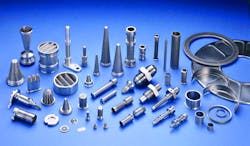Safety Screens and the ROB Factor
Safety screens are often referred to as last-chance filters, but they are not conventional filters and not rated as such. They offer a different type of protection from what hydraulic filters do. Safety screens typically trap contaminants 100 µm and larger in size.
System designers specify safety screens to catch large particles before they reach a critical component, such as a servovalve control orifice, or relief valve. A single large particle can cause sudden failure, possibly with catastrophic effects. Although filters maintain fluid cleanliness during operation, large particles (usually manufacturing debris in new systems or wear debris in older systems) require a different approach. Typical examples include machining chips, weld flash, seal fragments, wear particles, and debris from failing components. Here, safety screens provide an added level of protection.
Beta ratings—familiar to designers who specify conventional filters—do not apply to this type of device. And because most screens have holes larger than 100 µm, contamination specifications, such as ISO 4406, are useless. Unfortunately, no standard methods exist to compare the performance of one safety screen to another. As a result, hydraulic system designers often must resort to costly testing programs or haphazard trial-and-error methods to select the proper screen.
To provide a means of comparing the effectiveness of screens, The Lee Company developed the Resistance to Blockage (ROB) factor. The ROB factor is calculated from a volume of fluid with known contamination required to block a screen. MIL-STD 1246, which deals with large particle contamination, was chosen as the baseline for comparison. Using MIL-STD 1246Class 200 fluid, the ROB factor is defined as:
ROB = N / (63.25´n)
where: N = number of holes in screen
d = hole size in µm
A master screen where ROB = 1 one is defined as having 1,000 holes of 100 µm in size. Taking a ratio of any other screen to the master gives a comparison of the rate of blockage. Because a ratio is involved, many errors cancel. Factors such as flow rate and mode of clogging may be unknown, but both screens are affected in the same relative manner. For greatest protection, choose a safety screen with the highest ROB factor.
For more information on safety screens, contact The Lee Co., Westbrook, Conn., at (860) 399-6281, or visit www.theleeco.com.


